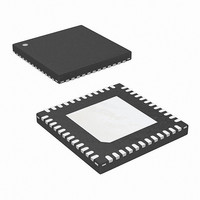ISL6327IRZ-T Intersil, ISL6327IRZ-T Datasheet - Page 22

ISL6327IRZ-T
Manufacturer Part Number
ISL6327IRZ-T
Description
IC CTRLR PWM 6PHASE BUCK 48-QFN
Manufacturer
Intersil
Datasheet
1.ISL6327CRZ.pdf
(29 pages)
Specifications of ISL6327IRZ-T
Pwm Type
Voltage Mode
Number Of Outputs
1
Frequency - Max
275kHz
Duty Cycle
25%
Voltage - Supply
4.75 V ~ 5.25 V
Buck
Yes
Boost
No
Flyback
No
Inverting
No
Doubler
No
Divider
No
Cuk
No
Isolated
No
Operating Temperature
-40°C ~ 85°C
Package / Case
48-VQFN
Frequency-max
275kHz
Lead Free Status / RoHS Status
Lead free / RoHS Compliant
Available stocks
Company
Part Number
Manufacturer
Quantity
Price
Part Number:
ISL6327IRZ-T
Manufacturer:
INTERSIL
Quantity:
20 000
In order to obtain the correct current information, there
should be a way to correct the temperature impact on the
current sense component. ISL6327 provides two methods:
integrated temperature compensation and external
temperature compensation.
Integrated Temperature Compensation
When TCOMP voltage is equal or greater than VCC/15,
ISL6327 will utilize the voltage at TM and TCOMP pins to
compensate the temperature impact on the sensed current.
The block diagram of this function is shown in Figure 15.
When the TM NTC is placed close to the current sense
component (inductor), the temperature of the NTC will track
the temperature of the current sense component. Therefore,
the TM voltage can be utilized to obtain the temperature of
the current sense component.
Based on VCC voltage, ISL6327 converts the TM pin voltage
to a 6-bit TM digital signal for temperature compensation.
With the non-linear A/D converter of ISL6327, TM digital
signal is linearly proportional to the NTC temperature. For
accurate temperature compensation, the ratio of the TM
voltage to the NTC temperature of the practical design
should be similar to that in Figure 13.
Depending on the location of the NTC and the air-flowing,
the NTC may be cooler or hotter than the current sense
component. TCOMP pin voltage can be utilized to correct
the temperature difference between NTC and the current
sense component. When a different NTC type or different
voltage divider is used for the TM function, TCOMP voltage
can also be used to compensate for the difference between
the recommended TM voltage curve in Figure 14 and that of
the actual design. According to the VCC voltage, ISL6327
converts the TCOMP pin voltage to a 4-bit TCOMP digital
signal as TCOMP factor N.
o
FIGURE 15. BLOCK DIAGRAM OF INTEGRATED
c
V
V
CC
CC
R
R
R
R
TCOMP
NTC
TM1
TC2
TC1
TM
TEMPERATURE COMPENSATION
Non-linear
4-bit
A/D
D/A
A/D
k
i
I
6
22
Over current protection
Channel current sense
I
5
Droop, Iout &
I
4
I
3
I
2
I
1
I
I
I
I
I
I
sen6
sen5
sen4
sen3
sen2
sen1
ISL6327
TCOMP factor N is an integer between 0 and 15. The
integrated temperature compensation function is disabled for
N = 0. For N = 4, the NTC temperature is equal to the
temperature of the current sense component. For N <4, the
NTC is hotter than the current sense component. The NTC is
cooler than the current sense component for N >4. When
N >4, the larger TCOMP factor N, the larger the difference
between the NTC temperature and the temperature of the
current sense component.
ISL6327 multiplexes the TCOMP factor N with the TM digital
signal to obtain the adjustment gain to compensate the
temperature impact on the sensed channel current. The
compensated channel current signal is used for droop and
overcurrent protection functions.
Design Procedure
10. Record the output voltage as V1 immediately after the
11. If the output voltage increases over 2mV as the
The design spreadsheet is available for those calculations.
1. Properly choose the voltage divider for TM pin to match
2. Run the actual board under the full load and the desired
3. After the board reaches the thermal steady state, record
4. Use Equation 21 to calculate the resistance of the TM
5. Use Equation 22 to calculate the TCOMP factor N:
6. Choose an integral number close to the above result for
7. Choose the pull-up resistor R
8. If N = 15, do not need the pull-down resistor R
9. Run the actual board under full load again with the proper
the TM voltage vs temperature curve with the
recommended curve in Figure 13.
cooling condition.
the temperature (T
(inductor) and the voltage at TM and VCC pins.
NTC, and find out the corresponding NTC temperature
T
the TCOMP factor. If this factor is higher than 15, use
N = 15. If it is less than 1, use N = 1.
otherwise obtain R
resistors to TCOMP pin.
output voltage is stable with the full load; record the
output voltage as V2 after the VR reaches the thermal
steady state.
temperature increases, i.e. V2 - V1 >2mV, reduce N and
redesign R
as the temperature increases, i.e. V1 - V2 >2mV,
increase N and redesign R
R
N
R
NTC
NTC T
TC2
=
209x T
------------------------------------------------------- -
(
from the NTC datasheet.
=
NTC
3xT
NxR
---------------------- -
(
15 N
TC2
NTC
)
CSC
–
TC1
=
; if the output voltage decreases over 2mV
V
------------------------------- -
V
+
–
TM
CC
400
T
CSC
TC2
NTC
xR
–
V
TM1
) of the current sense component
)
using Equation 23:
TM
+
4
TC2
TC1
.
(typical 10kΩ);
TC2
May 5, 2008
(EQ. 21)
(EQ. 22)
(EQ. 23)
FN9276.4
,











